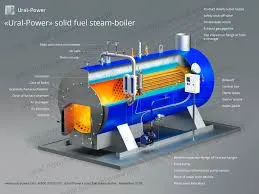
Jan . 15, 2025 03:54 Back to list
biomass fired thermal oil boiler
Biomass heating has emerged as a cornerstone in sustainable energy solutions. This form of heating harnesses organic materials - such as wood, agricultural residues, and specially grown energy crops - converted into heat energy. Unlike fossil fuels, biomass is renewable, releasing only the amount of carbon dioxide that the plants absorbed during their growth cycle. This presents a compelling alternative for reducing greenhouse gas emissions.
Ensuring authoritativeness in the biomass heating field requires staying abreast of technological advancements and regulatory changes. The European experience, where biomass heating is widespread due to favorable subsidies and stringent environmental standards, offers valuable insights. At international conferences, networking with German and Scandinavian manufacturers has confirmed that local adaptations—like integrating solar panels to augment biomass systems—can maximize efficiency even further. Finally, building trustworthiness stems from transparent interactions with clients and continual performance assessments post-installation. Clients appreciate periodic system check-ups and efficiency recalibrations, ensuring longevity and optimal performance. My practice involves offering detailed analysis during the consultation phase, simulating expected savings and environmental impact. This upfront approach not only cultivates trust but empowers clients, making them active participants in their sustainable energy journey. In conclusion, biomass heating is not just an ecological imperative but an economically sound decision when approached with expertise and foresight. For those willing to invest time into understanding their energy needs and local biomass availability, the benefits are plentiful. Adaptation, correct installation, and maintenance are key—as is situated knowledge of regional resources and regulations. With these insights, biomass heating can transition from a novel idea to a mainstream solution, benefiting both individuals and the planet.


Ensuring authoritativeness in the biomass heating field requires staying abreast of technological advancements and regulatory changes. The European experience, where biomass heating is widespread due to favorable subsidies and stringent environmental standards, offers valuable insights. At international conferences, networking with German and Scandinavian manufacturers has confirmed that local adaptations—like integrating solar panels to augment biomass systems—can maximize efficiency even further. Finally, building trustworthiness stems from transparent interactions with clients and continual performance assessments post-installation. Clients appreciate periodic system check-ups and efficiency recalibrations, ensuring longevity and optimal performance. My practice involves offering detailed analysis during the consultation phase, simulating expected savings and environmental impact. This upfront approach not only cultivates trust but empowers clients, making them active participants in their sustainable energy journey. In conclusion, biomass heating is not just an ecological imperative but an economically sound decision when approached with expertise and foresight. For those willing to invest time into understanding their energy needs and local biomass availability, the benefits are plentiful. Adaptation, correct installation, and maintenance are key—as is situated knowledge of regional resources and regulations. With these insights, biomass heating can transition from a novel idea to a mainstream solution, benefiting both individuals and the planet.
Share
Latest News
-
High-Efficiency Commercial Oil Fired Steam Boiler for Industry
NewsJul.30,2025
-
High-Efficiency Biomass Fired Thermal Oil Boiler Solutions
NewsJul.30,2025
-
High Efficiency Gas Fired Thermal Oil Boiler for Industrial Heating
NewsJul.29,2025
-
High-Efficiency Gas Fired Hot Water Boiler for Sale – Reliable & Affordable
NewsJul.29,2025
-
High Efficiency Biomass Fired Hot Water Boiler for Industrial and Commercial Use
NewsJul.29,2025
-
High-Efficiency Biomass Fired Hot Water Boiler for Industrial Use
NewsJul.28,2025
Related PRODUCTS
Copyright © 2025 HEBEI HONGZE BOILER MANUFACTURING CO., LTD. All Rights Reserved. Sitemap | Privacy Policy






















